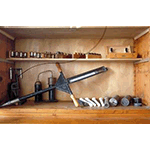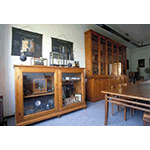Universitą degli Studi di Firenze - Dipartimento di Sanitą Pubblica [University of Florence - Public Health Department]
The teaching of Hygiene in Florence, at the Royal Institute of Practical Advanced Studies and Specialisation, began in 1878. The first professor, Giorgio Roster, was followed, over the course of sixty years, by such personages as Achille Sclavo, who developed the anticarbuncular fever serum, and Filippo Neri, who assiduously studied the problems linked to the bacteriological characteristics of water. But it was only with Giuseppe Mazzetti, professor at the University of Florence in 1936, that the educational activity was transferred from its modest premises in the Santa Maria Nuova Hospital to the building erected for this purpose at Careggi, where it assumed the official name of Institute of Hygiene and Microbiology. Mazzetti, director of the Institute up to 1969, contributed, along with his colleagues, to developing new branches of studies in Hygiene, linked to changes in the environmental and working conditions of the population. The growth and organic diversification of the structure led, in 1989, to the establishing of the new Department of Public Health, Epidemiology and Environmental Analytical Chemistry, which assumed its present name in 2000.
The Department possesses a collection of medical instruments (about 80 objects from the 19th and 20th centuries). The collection has recently been arranged for display, with instruments taken from the Institute’s storage deposits. It includes microscopes, apparatus pertinent to various aspects of environmental hygiene, scales and cameras from the Twenties and Thirties. The collection will soon be enriched by educational panels on canvas from the early 20th century, coming from the Institut Pasteur in Paris.
****************************
Texts by Elena Fani
English translation by Catherine Frost
Last update 29/gen/2008





